 |
| kym thalassoudis / skymaps.com; background: national aeronatics and space administration (nasa) |
| Scholars have identified 210 visible stars that carry Arabic names, some of which preserve older names that date back to Babylon and Sumeria. In this illustration, the 30 brightest stars with Arabic names appear as eight-pointed stars, in sizes adjusted for their relative magnitudes, or brightnesses. |
On March 3, 1995, when American astronomers Andrea Dupree and Ronald Gilliland trained the orbiting Hubble Telescope on the constellation of Orion the Hunter, they captured a historic photograph: the first-ever direct image of the disk of a star other than the Sun.
 ntil then, star photographs had shown only points of light, but Dupree and Gilliland produced an image large enough to give the star a shape. The center of the bright orange image showed a mysterious hot spot twice the diameter of the Earth's orbit, surrounded by an ultraviolet atmosphere that emits prodigious amounts of radiation.
ntil then, star photographs had shown only points of light, but Dupree and Gilliland produced an image large enough to give the star a shape. The center of the bright orange image showed a mysterious hot spot twice the diameter of the Earth's orbit, surrounded by an ultraviolet atmosphere that emits prodigious amounts of radiation.
The star was Betelgeuse, one of the most famous of the red supergiants and the second brightest star in Orion.
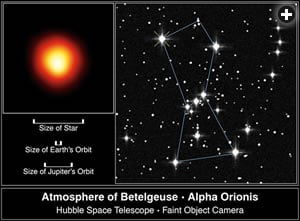 |
| nasa |
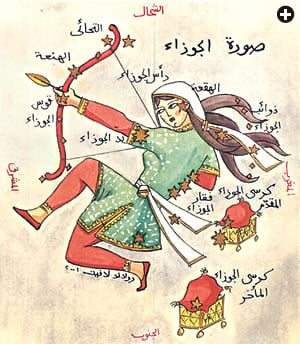 |
| roland laffitte, Héritage arabe: des noms arabes pour les étoiles (Paris, 2006). |
| The odd name of Betelgeuse, in the constellation Orion, comes from an Arabic original whose first letter was inadvertantly changed by a 13th-century astronomer. Second brightest in Orion, the star that was originally named in Arabic yad al-jawza’ appears (top) at the upper left, and above, in an antique-style rendition, at the end of the sleeve of the hunter’s tunic. |
Betelgeuse (pronounced beetle-jooz or sometimes bet-el-juice) is an odd name—but then most of the common star names sound strange to the western ear. The reason is that most of them are of Arabic origin: Aldebaran (“The Follower”), Algol (“The Ghoul”), Arrakis (“The Dancer”), Deneb (“Tail”), Fomalhaut (“The Fish's Mouth”), Rigel (“Foot”), Thuban (“Snake”), Vega (“Plunging [Eagle]”).… The list goes on.
The derivation of Betelgeuse is more problematic than most, but experts today trace the name back to the Arabic yad al-jawza', “The Hand of the Giant”—the giant being Orion. A transcription error, confusing the initial letters b and y (in Arabic, ba and ya) because of their similar shape, dates back to the 13th century, when a star table by John of London (who lived and worked in Paris) named the star Bedalgeuze. Accepting this form, European scholars like the French polymath Joseph Scaliger thought the name meant “Armpit of the Giant” (properly, ibt al-jawza'). But yad al-jawza' goes back at least as far as the star charts of the Muslim astronomer al-Sufi in the 10th century and is probably much older than that.
The 48 traditional star constellations—Andromeda, Hercules, Perseus and so on—have Latin names, and most of them represent Greek mythical figures. These names were passed on to us by Ptolemy of Alexandria, the second-century Egyptian–Greek astronomer whose view of the universe was bequeathed to the medieval world. (Many of the Greek star figures were themselves borrowed from the myths of ancient Egypt and Mesopotamia.) But many of the popular names of the visible stars in these constellations are nevertheless Arabic. Some came from the star pictures that early Bedouins saw in the night sky; others were Arabic translations of Ptolemy's Greek terms. Many of these names would be immediately recognized by Arabs today; others would not.
Some of the star names are fragments of longer Arabic names—often shortened to fit on medieval astronomical measurement devices called astrolabes. Some have been distorted beyond recognition over the centuries, due to transcription and copying errors. At least 210 of the stars most easily seen with the naked eye have names derived from Arabic words, according to science historian Paul Kunitzsch of the University of Munich, an acknowledged expert on Arabic star names.
Kunitzsch has done extensive research on the transmission of Arabic star names into European usage. Of the 210 Arabic star names he identified, he finds that 52 percent come from authentic Arabic originals, 39 percent from translated Ptolemaic originals, and 9 percent from conjecture, erroneous readings or artistic choice.
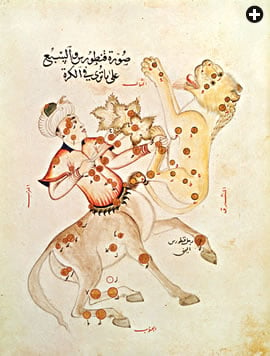 |
| bibliothéque nationale / Bridgeman art library |
| Most of the Arabic star names we know today can be traced back to the treatises of al-Sufi, a Persian astronomer of the 10th century who wrote in Arabic. His Book of Constellations of the Fixed Stars built on Ptolemy’s second-century Almagest. This plate is a 15th-century interpretation of al-Sufi’s constellations of Centaurus and Leo. |
The first wave of transmission of Arabic star names to Europe took place in the Middle Ages, from the 10th to the 13th centuries, and included about 48 names of the 210. This was the only period of direct “borrowings,” where star names were translated directly from Arabic star catalogs into corresponding European astronomical works. Most of the transmission occurred in Spain, where Christian astronomers were eager to learn from Muslim ones.
Kept alive for centuries by mariners, explorers and other stargazers, the Arabic star names are a living testimony to the golden age of Arab–Islamic astronomy. From the ninth to the 15th century, scientists working in the Arabic language, in a region stretching from Islamic Spain across North Africa and the Middle East to India, dominated worldwide scientific endeavor and provided the raw material for Europe's intellectual renaissance. Astronomy was one of the greatest of these pursuits.
Before Copernicus in the early 16th century, European and Muslim astronomers alike followed the cosmological model set forth by Ptolemy of Alexandria. According to Ptolemy, the Earth, at the center of the universe, was surrounded by a series of concentric translucent shells to which were attached the moon, sun, planets and fixed stars. The Arab astronomers translated Ptolemy's Greek star names into Arabic, and added some of their own that had been passed down by nomadic ancestors who used the stars and star-pictures to guide their passage through the great deserts of the Middle East. According to Kunitzsch and others, the Arabs also preserved star names from the Mesopotamian civilizations of the Sumerians and Babylonians.
Most of the Arabic star names we use today can be traced back to the star catalogue of the astronomer al-Sufi, known in medieval Europe as Azophi. His full name was Abu 'l-Hussain 'Abd al-Rahman ibn Omar al-Sufi, and he is recognized today as one of the most important scientists of his age.
Born in Rayy, Persia, in the late ninth century, al-Sufi studied and wrote in Arabic. Under the patronage of the Buwayhid Dynasty, he conducted astronomical observations in his homeland and in Baghdad, capital of the realm. His mentor was Ibn al-Amid, the vizier of the Buwayhid ruler. Ibn al-Amid wrote the foreword for one of al-Sufi's books, a major work on the astrolabe.
Al-Sufi was a conscientious observer of the fixed stars. In his day, the definitive guidebook for study of the stars was many centuries old: the Almagest, compiled by Ptolemy in about 150 ce. The Almagest was Ptolemy's greatest mathematical and astronomical work, and it had a major influence on Islamic and European science for more than a millennium. In 903, al-Sufi published the first-ever critical revision of Ptolemy's star catalogue. He corrected erroneous observations and added others not recorded by the Greek master astronomer. Al-Sufi's treatise on star cartography, or uranography, was called The Book of Constellations of the Fixed Stars (Kitab Suwar al-Kawakib al-Thabita) and became a classic of Islamic astronomy.
The book covers all 48 constellations in the Ptolemaic system. The stars of each constellation are described in detail—positions, colors and brightness, or magnitude—with criticisms of some of Ptolemy's measurements that al-Sufi found to be in error. Al-Sufi's work was groundbreaking science for several reasons. It provided real star observations, at a time when most astronomers relied on the ancient measurements of Ptolemy's star catalogue.
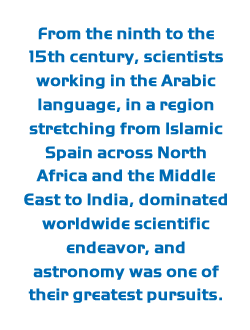 It was also the first scientific effort to identify the old Arabic star names with astronomically located stars. Before al-Sufi, the wealth of star names had been handed down in literary or philological works, with little regard for identifying which stars they actually applied to. Al-Sufi was not 100 percent successful in his identifications, for some of the names were associated with more than one star in a single constellation or with several stars in different celestial images. But he pinned down most of them, so that his catalogue became the primary source for Arabic star names for centuries to come. Most of the names that we use today came to us from al-Sufi's list, either via the European–Mediterranean civilization of the Greeks or through the Arab–Islamic civilization. (The process was complicated by the fact that the Arabs translated Ptolemy's work, including its Greek star names, into Arabic and passed it along to the Europeans, who had lost the original Greek version until the 15th century.)
It was also the first scientific effort to identify the old Arabic star names with astronomically located stars. Before al-Sufi, the wealth of star names had been handed down in literary or philological works, with little regard for identifying which stars they actually applied to. Al-Sufi was not 100 percent successful in his identifications, for some of the names were associated with more than one star in a single constellation or with several stars in different celestial images. But he pinned down most of them, so that his catalogue became the primary source for Arabic star names for centuries to come. Most of the names that we use today came to us from al-Sufi's list, either via the European–Mediterranean civilization of the Greeks or through the Arab–Islamic civilization. (The process was complicated by the fact that the Arabs translated Ptolemy's work, including its Greek star names, into Arabic and passed it along to the Europeans, who had lost the original Greek version until the 15th century.)
The very earliest Latin sources for Arabic star names were two 12th-century instruction manuals for astrolabes: De mensura astrolabii by Hermann of Reichenau and De utilitatibus astrolabii, attributed from earliest times to Gerbert d'Aurillac but now considered to be of uncertain authorship (with one section attributed to Hermann). Both works, probably composed in Spain, contain a handful of Arabic star names whose form has remained unchanged down to the present day, including Aldebaran, Algol, Alhabor (an alternate name for Sirius), Rigel and Vega.
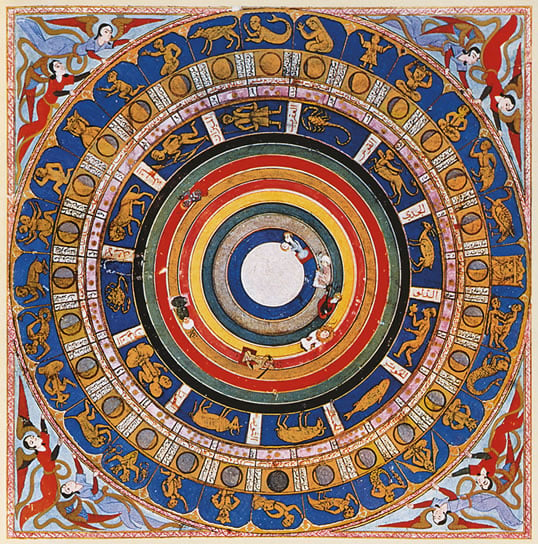 |
| Zubdet ut Tevarih by Lokman, 1583 / Topkapi Palace Museum / Bridgeman Art Library |
| This celestial map or macrocosm is the opening miniature in the Turkish Zubdat al-Tawarikh, or History of the World, showing the seven heavens above the Earth, the signs of the zodiac and the 28 lunar “mansions.” The model for it is essentially Ptolemaic, that is, Earth-centered, even though it was produced in 1583, four decades after Copernicus proposed the solar-system model we know today. |
Al-Sufi's work first became known in the West through Spain, where Christian and Muslim kingdoms coexisted and, when they were not jostling for influence or territory, cooperated. Christian king Alfonsox of Castile (known as Alfonso the Wise), a serious student of astronomy, ordered a free translation or adaptation of al-Sufi into Old Spanish, called the Libros de las Estrellas de la Ochaua Espera (1252–1256), and added it to his omnibus astronomy “textbook” known as the Libros del Saber de Astronomía (Books of Astronomical Knowledge). This opus also included the Alfonsine Tables, which furnished new data for calculating the positions of the Sun, Moon and planets in relation to the fixed stars, and revised the numbers in the Toledan Tables originally compiled by Andalusian astronomer al-Zarqali (called Arzachel in Europe) several centuries earlier.
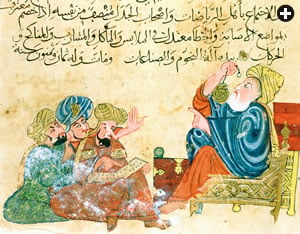 |
| topkapi palace museum / bridgeman art library |
| In a 13th-century Turkish miniature, Aristotle instructs students in the use of the astrolabe, a tool for measuring astronomical altitudes. First invented in Greece, it was extensively refined by Arab astronomers. |
In the East, meanwhile, al-Sufi's book was regarded as canonical and was relied upon through the centuries by the great astronomers of the Islamic world, including one with a substantial impact on the West, Ulugh Beg of Samarkand (1394–1449). The nomenclature of the later Oriental star catalogues, celestial globes and other instruments went back mostly to al-Sufi or Ulugh Beg.
“Ulugh Beg” means “the Great Prince.” His real name was Muhammad Taragay. Raised in the court of his grandfather, the Mongol conqueror Timur (Tamerlane), Ulugh Beg spent much of his youth traveling throughout the Middle East, moving from one conquered city to the next. After Tamerlane's death, his son Shah Rukh inherited most of his realm, known to us as the Timurid Empire, and Shah Rukh appointed his own 16-year-old son Ulugh Beg to rule over Samarkand, the old Timurid capital, while he went on to establish a new political capital for the empire in Herat, Afghanistan. Ulugh Beg ruled Samarkand and its surrounding province for 40 years. He served briefly as ruler of the overall Timurid Empire, succeeding Shah Rukh, from 1447-1449.
Ulugh Beg became not only a patron of mathematics and astronomy but also an exceptional astronomer himself. He believed that the “hard sciences” were different from theology and literature, that they transcended societal and religious boundaries and were held in common by all peoples, regardless of faith or language. The prince collaborated with numerous leading scientists of his day and founded at Samarkand one of the largest and most important observatories in the Islamic world. Supporting the observatory was a center for astronomical studies; Ulugh Beg handpicked its scientists from among the empire's best. At its peak the observatory employed 60 to 70 working astronomers. With these impressive scientific resources, Ulugh Beg set in motion a project to compile the Zij-i Sultani star catalogue (published in 1437), listing names and freshly observed positions for 994 fixed stars, a work often described as comparable to al-Sufi's. In fact, the catalogue included 27 stars from al-Sufi's own work that were too far south in the heavens to be observed from Samarkand.
The Second Wave
 The second wave of Arabic-origin star names arrived in late-Renaissance Europe in the 16th and 17th centuries. During this period some 22 additional Arabic star names entered common use in Europe, both among scientists and in literature. Most of them were introduced by a German lawyer and amateur astronomer named Johann Bayer.
The second wave of Arabic-origin star names arrived in late-Renaissance Europe in the 16th and 17th centuries. During this period some 22 additional Arabic star names entered common use in Europe, both among scientists and in literature. Most of them were introduced by a German lawyer and amateur astronomer named Johann Bayer.
Bayer was born in Rain, Bavaria in 1572. He studied philosophy at Ingolstadt University and later earned a law degree at Augsburg. He worked as a lawyer in Augsburg and served as a magistrate there. Bayer also happened to be a talented and serious amateur astronomer, and in 1603, at the age of 31—just six years before Galileo introduced the first telescope to the field of astronomy—Bayer published an important astronomical work, the Uranometria, which has been described as the first modern star atlas, and which became the standard reference for all later atlases. Though later astronomers named new constellations and introduced new projection systems, as well as totally different artistic styles for drawings of the constellations, the Bayer influence was always present: The Uranometria is always the implied standard of comparison.
The Bayer atlas contains 51 star maps or charts—one for each of the 48 traditional constellations of Ptolemy, plus a chart of the recently discovered southern skies and two planispheres, or flat representations of the celestial hemispheres (northern and southern). The Uranometria's star maps were engraved on copper plates by Alexander Mair and are large, over 37 centimeters (141/2") across. Each has an engraved grid, so the star positions can be determined to a fraction of a degree. Bayer took these highly accurate celestial positions from the new star catalogue of Danish astronomer Tycho Brahe, which had circulated in manuscript form in the 1590's but was not printed until 1602, one year before the Uranometria.
An important feature of Bayer's atlas was his new system of star nomenclature. He assigned Greek letters to the brighter stars, usually in order of magnitude. For example, the bright star in Taurus, the bull's eye, became α Tauri or Alpha Tauri. The Greek letters were recorded on the charts themselves and also in accompanying tables. Today's astronomers still use the binomial designation invented by Bayer.
For our purposes, however, the most relevant feature of the Bayer atlas is his recording of popular names for important stars, drawn from the works of Ptolemy and his successors, to assure that all known stars could be identified with those listed in the Bayer atlas. Bayer relied in large part on the first printed edition (published in Venice in 1515) of Gerard of Cremona's 1175 Latin translation of the Arabic version of Ptolemy's Almagest, as well as on the Alfonsine Tables and other parts of the astronomy “textbook” of Alfonso x, including an old-Spanish (Castilian) translation of al-Sufi's Book of Constellations of the Fixed Stars. He also consulted important commentaries on these works by Joseph Scaliger and by the Dutch philosopher and theologian Hugo Grotius.
In 1665, English orientalist Thomas Hyde published the first-ever translation of Ulugh Beg's star tables for European readers, with an extensive commentary on the star names. This Latin work, published at Oxford, bore the appropriately scholarly title Tabulae longitudinis et latitudinis stellarum fixarum ex observatione Ulugh Beighi. As we shall see, this translation and commentary was particularly valuable during the third wave.
Among the other scholars who contributed Arabic star names to the European corpus during the second wave were three noteworthy Germans:
Jakob von Christmann (1554–1613) was an orientalist who developed an interest in astronomy and in 1590 published a Latin translation of the writings of al-Farghani (called Alfraganus in Europe), a prominent ninth-century Abbasid astronomer who worked at the famed Baghdad center of learning, Bayt al-Hikma.
Wilhelm Schickard (1592–1635), mathematician, astronomer and orientalist, invented a mechanical calculating machine that could add, subtract, multiply and divide—a device sadly lost in the chaos of the Thirty Years' War and forgotten for three centuries.
Philippus Caesius (Philipp von Zesen) (1619–1689), poet and author, wrote a work in Latin in 1662 about the constellations and the legends attached to them, in the light of contemporary astronomy.
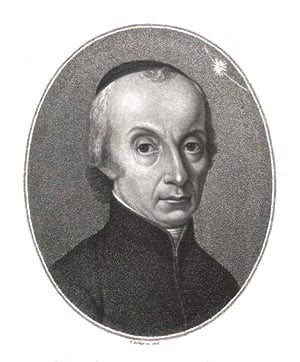 |
| wikimedia commons |
| In the late 1700’s, Giuseppe Piazzi of Palermo cataloged 6784 star names, producing what became the standard reference work of the 19th century. |
The Third Wave
The third wave of Arabic star names came to Europe in the early 19th century. As in the second wave, western astronomers took what became modern star names not from the original Arabic sources, such as al-Sufi or Ulugh Beg, but from translations of these sources—that is, from European renderings of the Arabic star nomenclature. Some 140, or two-thirds, of the Arabic-origin names entered the European star charts during this period, 94 of them from a single star catalogue published in 1803 by the Italian astronomer Giuseppe Piazzi (1746–1826).
Piazzi, a native of Lombardy, is perhaps best known today for his discovery of the first “asteroid,” Ceres, in 1801. (Ceres, with a diameter of about 950 kilometers [590 mi], is now considered a dwarf planet.) Piazzi, a Catholic priest, taught higher mathematics and then astronomy at the University of Palermo. Prince Caramanico, viceroy of Sicily, commissioned him to build an observatory there. In preparation, Piazzi spent from 1787 to 1789 in France and England, studying practical techniques under world-class astronomers and acquiring instruments for the Palermo Observatory. The most famous of these acquisitions was a unique 150-centimeter (5') circular-scale altazimuth telescope built by the renowned instrument-maker Jesse Ramsden of London. Piazzi used this telescope in compiling his famous star catalogue, containing 6784 stars (7464 entries in the revised 1814 edition), recorded with an accuracy never before possible.
For star names, Piazzi's Palermo catalogue relied heavily on Hyde's 1665 translation of the Ulugh Beg star list. (Despite its age, Hyde's work had remarkable staying power, being reprinted, with corrections, at Oxford in 1767 by Gregory Sharpe and in London in 1843 by Francis Bailly, among others, up to the modern era.)
“Piazzi fashioned his new names from Hyde's transcriptions of the names used by Ulugh Beg in the table text as well as names and endings brought forward in the commentary from all other sources,” Kunitzsch said in his 1959 classic Arabische Sternnamen in Europa (Arabic Star Names in Europe). “In general he does not follow Hyde's orthography very exactly. Many simplifications are introduced.” Piazzi also occasionally relied on German astronomer Johann Bode's star atlas Uranographie (1801) for some of his star-name forms, Kunitzsch found. Whatever their sources, Piazzi's star names enjoyed wide circulation. His catalogue was regarded as a standard reference work of the 19th century and was of great value to European and North American astronomers well into the 20th century.
Several other western scholars played significant roles during the third wave. Ludwig Ideler (1766–1846), a prominent Prussian chronologist and astronomer, made some noteworthy contributions to the understanding of Arabic star names. In 1809, he published a major work on the origin and meaning of star names that incorporated his own translation of the astronomical section of Zakariya' al-Qazwini's popular 13th-century cosmography, 'Aja'ib al-Makhluqat (The Wonders of Creation), supplemented with notes from classical and other sources.
 Ideler was the first western scholar to divide Arabic star names into two groups: truly Arabic names and those which the Arabs fashioned by translating Ptolemy's Greek descriptions of stars' positions in the constellations. Ideler's book was used as a basic reference source in the West for over 150 years. Sadly, as Kunitzsch and other modern experts note, Ideler did not have access to al-Sufi's book on the fixed stars, and his work is riddled with errors due to his use of unreliable and chiefly secondary Arabic sources.
Ideler was the first western scholar to divide Arabic star names into two groups: truly Arabic names and those which the Arabs fashioned by translating Ptolemy's Greek descriptions of stars' positions in the constellations. Ideler's book was used as a basic reference source in the West for over 150 years. Sadly, as Kunitzsch and other modern experts note, Ideler did not have access to al-Sufi's book on the fixed stars, and his work is riddled with errors due to his use of unreliable and chiefly secondary Arabic sources.
Richard Hinckley Allen (1838–1908), an American churchman, teacher and naturalist from Buffalo, New York, was another important figure in the third wave, known more for his passion than for his accuracy. He became interested in the history of star names after coming across a reference to a star with a strange name: Hamal (“The Ram” in Arabic), also known as Alpha Arietis, the first star in the constellation Ares. His interest developed into a hobby and then into a lifelong avocation. As was said at a memorial service after his death, “Like a prophet of the night, when the light of the day had vanished, he would name star after star, ... speaking of their relations to one another, and of the meaning of their names, as if he were more at home among their glories than most men would be with the persons and things of their daily environment.”
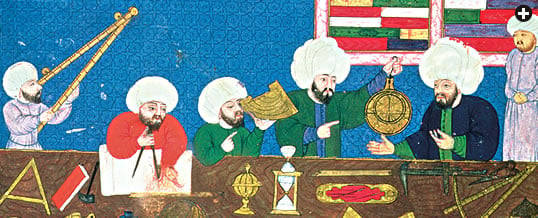 |
| istanbul university library / bridgeman art library (detail) |
| Working in the Galata Observatory founded near Istanbul in the late 16th century by the Turkish astronomer Takyuddin, astronomers had access to the best reference works and technology of the era. |
Allen compiled a comprehensive work on star-name lore, published in 1899 as Star-Names and Their Meanings (later reprinted as Star-Names: Their Lore and Meaning), which drew much of its material from Ideler and thus repeated many of that scholar's errors. But Allen also helped popularize the names we have encountered that passed from Ptolemy and al-Sufi to Ulugh Beg and Bayer and Piazzi, as well as along other routes. Allen's book was if anything more influential than Ideler's on the popular understanding of star names, particularly those of Arabic origin, and is still often quoted today. Some of Allen's variants on these names have ended up in modern reference works, including the American Nautical Almanac and Webster's International Dictionary. At the same time, most of Allen's predecessors—the European and Arabic-speaking astronomers, cosmographers, philologists and others that he cites extensively in his book—remain shrouded in obscurity and in many cases have been virtually forgotten.
These, then, were the waves of knowledge that brought the Arabic-origin star names to the West:
The First Wave of medieval times, with the greatest number of Arabic star names, including the Ptolemaic corpus (150 ce), moving from al-Sufi (964 ce) to the astronomical compendium of Spain's King Alfonso x.
The Second Wave of the late Renaissance, with most of the star names moving from the first printed edition of the works of Alfonso x (1483) and from the first printed edition of Ptolemy's Almagest (Gerard's 1175 Latin translation from Arabic, published in 1515) to Bayer's Uranometria (1603).
The Third Wave of the 19th century, with most of the star names transmitted from al-Sufi to Ulugh Beg's star list to Hyde's translation (1665) to Piazzi's Palermo star catalogue (1803).
In part because of this complicated transmission process, the Arabic star names in use today are neither uniform nor consistent but rather, according to Kunitzsch, “a conglomeration of heterogeneous words fashioned at different times and in different ways.” Direct borrowings happened only during the Middle Ages. The word formations of the second and third waves are indirect borrowings—cases in which astronomers have taken terms from translations that appear in the European literature. But regardless of the nature of the borrowing, the process continued for almost a millennium, with new influxes of Arabic star names entering the literature of the West from time to time through the centuries. This process resembles, in a way, the periodic pulsations of brightness of the star Algol in Perseus, sometimes referred to as “The Winking Demon”—a star that, as you know by now, was named for us by the Arabs.
 |
Robert W. Lebling is a writer and communication specialist based in Dhahran and a longtime contributor to Saudi Aramco World. His latest book is Legends of the Fire Spirits: Jinn and Genies from Arabia to Zanzibar (I.B.Tauris, 2010). |





